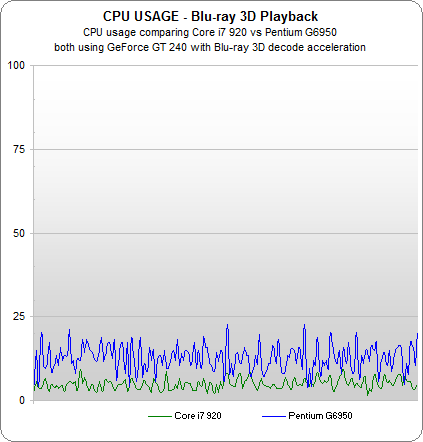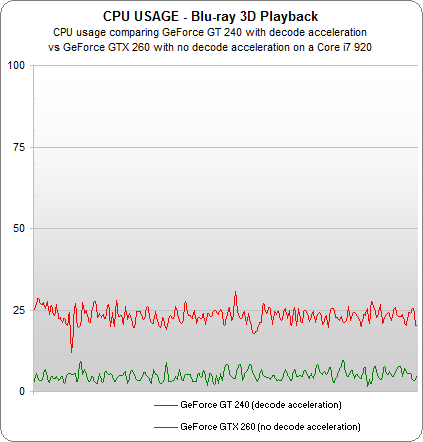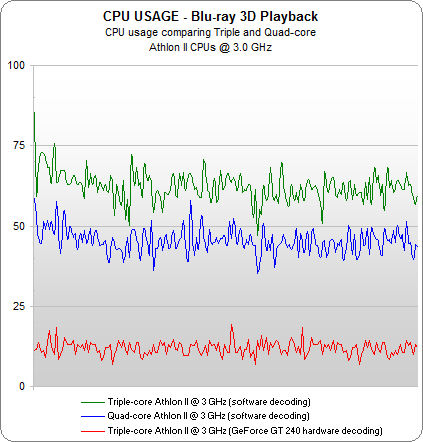Blu-ray 3D On The PC: The Tom's Hardware Review
Tom's Hardware has an exclusive first-look at Blu-ray 3D technology running on a notebook and HTPC leveraging Nvidia's 3D Vision technology, CyberLink's PowerDVD 10 Ultra Mark II software, and an Acer display. Might this setup be in your future, too?
Benchmark Results: CPU Utilization
Objective testing turns out to be a lot more difficult than we might have first hoped. The problem is that none of the software involved is designed to allow hardware acceleration to be disabled. Turning off GeForce hardware acceleration in PowerDVD has no effect, and the program appears to continue to lean on Nvidia's VP4 engine for MVC decoding.
We can extract some useful data from these test systems anyway, because the GeForce GT 240 card in the HTPC is essentially identical to the GeForce GT 240 in the test system we put together. This gives us a great opportunity to test the CPU utilization on different CPUs when using similar graphics hardware:
A you can see, the dual-core Pentium G6950 demonstrates an average CPU utilization of just under 20% during Blu-ray 3D playback when a GeForce GT 240 is handling decode acceleration. On our Core i7-920, CPU utilization appears to be about half of that, or just under 10%.
Now, we might not be able to turn off hardware acceleration, but we can try things out with a card that doesn't support Blu-ray 3D's MVC codec. Here's how the GeForce GT 240 (a card with Blu-ray 3D-decode acceleration) compares with a GeForce GTX 260 (a card without Blu-ray 3D decode acceleration) on our Core i7-equipped test machine:
There is certainly a dramatic increase in CPU utilization here, from just under 10% with the GT 240 to about two and a half times that with the GeForce GTX 260.
With the Core i7 CPU under 30% of load, we can tell more CPU power is required, but the i7 is far from its limits. The question remains: how much CPU do you need for a graphics card that doesn't support MVC decoding?
We put together an Athlon II system for testing. The system allowed us to put quad and triple-core Athlon II CPU software decoding to the test. However, we couldn't get a dual-core CPU to play back Blu-ray 3D on our test system. Here are the results:
Get Tom's Hardware's best news and in-depth reviews, straight to your inbox.
As you can see, the triple-core Athlon II X3 440 at 3 GHz is highly stressed during Blu-ray 3D playback. It's difficult to make precise conclusions without per-core utilization data but CyberLink's software decoder appears to take advantage of threading, a feature that quad-core owners will appreciate. Judging from the performance we've seen, we think Blu-ray 3D can be comfortably played back with a triple-core CPU at 3 GHz or a quad-core CPU at 2.5 GHz using PowerDVD's software decoder.
Current page: Benchmark Results: CPU Utilization
Prev Page Test Systems And Benchmarks Next Page Subjective Tests: Does Blu-ray 3D Live Up To The Hype?Don Woligroski was a former senior hardware editor for Tom's Hardware. He has covered a wide range of PC hardware topics, including CPUs, GPUs, system building, and emerging technologies.
-
Annisman The big issue I have with Blu-Ray on the PC is this: There is no free, or reasonably priced software to play Blu-Ray disks. I was pretty much forced to purchase Power DVD 10 Ultra for 110$, as there is no other application that I have found to watch Blu-Ray with. Of course you can 'screw the man' and go pirate Power DVD, but that's probably the main reason I have to shell out over a hundred bucks for the software in the first place. We need an integrated software solution for BD as it is becoming more mainstream. What happened to Blu-Ray playback being included with WMP for Windows 7 ? VLC doesn't even have a solution, what is the reason we don't have 3rd party BD software yet ? Until that is addressed, I can't see Blu-Ray on the PC being viable.Reply -
joytech22 I gotta say i own Nvidia's 3D vision kit + a BD drive + a GTX470 and i just cant wait until the 3D Blu-Ray's are released but first i need to replace my Samsung 2233RZ since the top 15-20% is no longer in 3D.Reply
So far i have had a Very positive experience with Nvidia's solution! -
ajy0903 And also we need to have bigger 3D monitor for PC then what they have currently!!!!!!!!!Reply -
jrazor247 seems most 3d movies are cg currently. probably the entire tool chain to edit and post process digital film has to be upgraded. adding stereoscopic cameras to production is probably the easiest. in a computer generated movie, all the processing can be converted to 3d almost natively in the rendering software. I went to a see the 3d vision setup at a blockbuster near my house. it showed games and animated movies in 3d. the real wow effect came watching footage of people skydiving in 3d. once 3d video production ramps up, its here to stay. i would be addicted to watching sports and performances in 3d. the next road block would be distribution, as the cable and sat providers would have to double bandwidth - artifacts from over compression would def ruin 3d.Reply -
johnb4467 If the hardware settles 7 stabilizes, this is something I would be interested in, whether it's for the PC or the upcoming PS3 firmware update.Reply
I do agree, however, that there needs to be more built-in support for software. I'm sure that will find its way into apps such as XBMC and Plex eventually.
This is going to be hardest for consumers to adopt who have sunk a lot of money into existing HDTV's...especially ones who 'claimed' 120hz refresh rates -- but won't work with 3D. My own TV is a low-end Westinghouse 1080p, so down the road I wouldn't mind upgrading...if the material and quality is there!
FYI: I had older shutter glasses on my old PC & CRT display -- with a fast enough refresh rate...no headaches; it's really not an issue (current demos have confirmed this). -
toxxel I wear glasses already, wearing another pair of glasses over my own is an annoyance. I've never really been a fan of 3D since my eyesight mostly keeps me from seeing anything 3D. I can see nearly perfect out of one eye but the other is another story. My first experience of a 3D polarized movie was Avatar. What I saw didn't impress, blurriness, strange effects from pronounced objects on the screen, felt distracted and ruined many scenes. I understand it's my eyesight that caused problems but I feel 3D won't become main stream simply because of the glasses, but if it were to I'd feel completely alienated seeing I don't have the same experience.Reply -
gti88 Unfortunately, I don't expect the 3d to come to Formula 1 soon. At least, until Ecclestone is no longer in charge.Reply -
jsm6746 this is mostly a rehash of the article you posted by cyberlink's tom vaughan yesterday... i must say i found his article much more informative... the benchmarks were all that was needed in this... the opinion piece was unnecessary... O_oReply
http://www.tomshardware.com/reviews/blu-ray-3d-3d-video-3d-tv,2632.html -
cleeve jsm6746this is mostly a rehash of the article you posted by cyberlink's tom vaughan yesterday...Reply
I disagree with you there. Tom's article is a great Blu-ray 3D white paper, but it's not a Blu-ray 3D review. We did have to duplicate some of the information briefly so this article could stand on its own, but the focus of either article is quite different.
-
cknobman 3d at home can suck it.Reply
New tv's, special glasses, limited viewing angles, new media, new monitors, special software to play them, new blue ray players, etc.., etc...
Not to mention the general discomfort associated with having to watch things in 3d, the fact that 3d is NOT suitable for all situations, many people in the general public have an impairment that wont allow them to enjoy 3d, etc.., etc...
Let this fad fade away and quickly!!! Im not reinvesting thousands and thousands of dollars into this new marketing gimmick. Its another way for the entertainment industry to make even more money off us. Now the push it to make all movies 3d and charge a mandatory 15-20 bucks per ticket to see it.
Its just sad there is such a large portion of the population that mindlessly follows anything presented to them and like zombies will pay what they are told without regard to the cost/benefit ratio.


